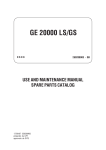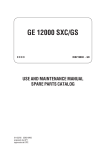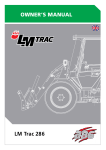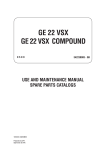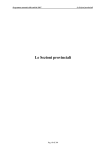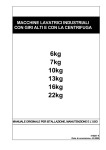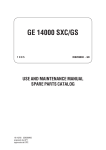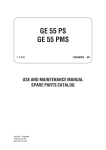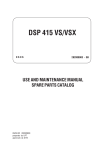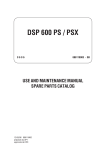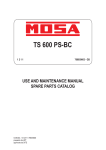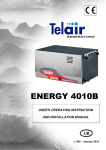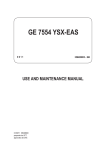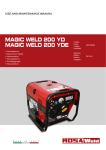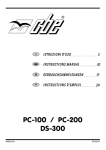Download GE 15 LS LSX 1007
Transcript
GE 15 LS - LSX 1007 741509003 - GB USE AND MAINTENANCE MANUAL SPARE PARTS CATALOG 12/06/03 74150M00 preparato da UPT approvato da DITE DESCRIPTION OF THE MACHINE © MOSA GE 15 LS - LSX M 0 REV.1-10/07 Main Characteristics of the unit: • Three-phase electric power (max) 12.8 kW / 400 V / 50 Hz. • Lombardini Diesel engine LDW 1603 CHD • Synchronous alternator with brush and compound • Tank of 60l with autonomy of 17 h • Dimensions / weight, 1720x980x1060 / 530 (LS) - 540 (LSX) Kg • Noise level at 7m 70dBA (LS) - 68dBA (LSX) • Prepared for automatic start unit • Prepared for remote start/stop. FILTER BATTERY CONNECTOR FOR EAS OR REMOTE START EMERGENCY STOP The unit is composed of: a structured base which includes a tank, an engine/alternator unit fixed on the base by 3 elastic dampers, a roll-bar, with hook for an easy and sure lifting, a chest hinged to the roll-bar for a quick access to the engine, a front panel covered with a lid where are mounted the sockets , the protections and the measure instruments. The battery and the engine air filter are protected by a plate hinged to roll-bar and fixed to the structure with 2 rapid block screws with a wrench given as equipment not to be lost. M Quality system © MOSA GE_, MS_, TS_, EAS_ 01 1.2-05/03 UNI EN ISO 9001 : 2000 MOSA has certified its quality system according to UNI EN ISO 9001:2000 to ensure a constant, high quality of its products. This certification covers the design, production and servicing of engine driven welders and generating sets. The advantages for MOSA clients are: The certifying institute, ICIM, which is a member of the International Certification Network IQNet, awarded the official approval to MOSA after an examination of its operations at the head office and plant in Cusago (MI), Italy. · Competent support in the solution of problems; · Continuous efforts to improve the products and their performance at competitive conditions; · Information and training in the correct application and use of the products to assure the security of the operator and protect the environment; · Regular inspections by ICIM to confirm that the requirements of the company’s quality system and ISO 9001 are being respected. All these advantages are guaranteed by the CERTIFICATE OF QUALITY SYSTEM No.0192 issued by ICIM S.p.A. - Milano (Italy ) - www.icim.it 10/10/02 M01-GB This certification is not a point of arrival but a pledge on the part of the entire company to maintain a level of quality of both its products and services which will continue to satisfy the needs of its clients, as well as to improve the transparency and the communications regarding all the company’s actives in accordance with the official procedures and in harmony with the MOSA Manual of Quality. · Constant quality of products and services at the high level which the client expects; Index M 1 REV.1-10/07 M 00 M 01 M 1.01 M 1.1 M 1.4 M 1.5 M 2 .... M 2.3 -…. M 2.5 -…. M 2.6 M 2.7 M3 M4 M 6.3 M 20.... M 21 M 22 M 31 M 37... M 38.5.1 M 39.4 M 40.2... M 43… M 45 M 46 M 53 M 60 M 61-….. DESCRIPTION OF THE MACHINE QUALITY SYSTEM COPYRIGHT NOTES CE MARK TECHNICAL DATA SYMBOLS AND SAFETY PRECAUTIONS ABBREVIATIONS LEGEND INSTALLATION AND ADVICE BEFORE USE INSTALLATION AND ADVICE INSTALLATION UNPACKING TRANSPORT AND DISPLACEMENTS COVERED UNITS ASSEMBLY CTL22 PREPARING THE UNIT START-UP SHUTTING DOWN THE MOTOR CONTROLS USING THE GENERATOR REMOTE CONTROL ENGINE PROTECTION ES - EV TROUBLESHOOTING MAINTENANCE STORAGE CUST OFF DIMENSIONS ELECTRICAL SYSTEM LEGENDE ELECTRICAL SYSTEM R1 IB ... SPARE PARTS LIST SPARE PARTS 12/06/03 74150-GB © MOSA GE 15 LS - LSX Copyright © MOSA GE_, MS_, TS_, EAS M 1.01 1.0-10/02 ATTENTION This use and maintenance manual is an important part of the machines in question. The assistance and maintenance personel must keep said manual at disposal, as well as that for the engine and alternator (if the machine is synchronous) and all other documentation about the machine. We advise you to pay attention to the pages concerning the security (see page M1.1). © All rights are reserved to said Company. It is a property logo of MOSA division of B.C.S. S.p.A. All other possible logos contained in the documentation are registered by the respective owners. ➠ The reproduction and total or partial use, in any form and/or with any means, of the documentation is allowed to nobody without a written permission by MOSA division of B.C.S. S.p.A. To this aim is reminded the protection of the author’s right and the rights connected to the creation and design for communication, as provided by the laws in force in the matter. In no case MOSA division of B.C.S. S.p.A. will be held responsible for any damaga, direct or indirect, in relation with the use of the given information. 10/10/02 M1-01-GB MOSA division of B.C.S. S.p.A. does not take any responsibility about the shown information on firms or individuals, but keeps the right to refuse services or information publication which it judges discutible, unright or illegal. Notes © MOSA GE_, MS_, TS_, EAS_ M 1-1 1.0-10/02 INFORMATION Dear Customer, We wish to thank you for having bought from MOSA a high quality set. Our sections for Technical Service and Spare Parts will work at best to help you if it were necessary. To this purpose we advise you, for all control and overhaul operations, to turn to the nearest authorized Service Centre, where you will obtain a prompt and specialized intervention. ☞ In case you do not profit on these Services and some parts are replaced, please ask and be sure that are used exclusively original MOSA parts; this to guarantee that the performances and the initial safety prescribed by the norms in force are re-established. ☞ The use of non original spare parts will cancel immediately any guarantee and Technical Service obligation from MOSA. NOTES ABOUT THE MANUAL Before actioning the machine please read this manual attentively. Follow the instructions contained in it, in this way you will avoid inconveniences due to negligence, mistakes or incorrect maintenance. The manual is for qualified personnel, who knows the rules: about safety and health, installation and use of sets movable as well as fixed. INFORMATION OF GENERAL TYPE In the envelope given together with the machine and/or set you will find: the manual for Use Maintenance and Spare Parts, the manual for use of the engine and the tools (if included in the equipment), the guarantee (in the countries where it is prescribed by law). Our products have been designed for the use of generation for welding, electric and hydraulic system; ANY OTHER DIFFERENT USE NOT INCLUDED IN THE ONE INDICATED, relieves MOSA from the risks which could happen or, anyway, from that which was agreed when selling the machine; MOSA excludes any responsibility for damages to the machine, to the things or to persons in this case. Our products are made in conformity with the safety norms in force, for which it is advisable to use all these devices or information so that the use does not bring damage to persons or things. While working it is advisable to keep to the personal safety norms in force in the countries to which the product is destined (clothing, work tools, etc.). Do not modify for any motive parts of the machine (fastenings, holes, electric or mechanical devices, others..) if not duly authorized in writing by MOSA: the responsibility coming from any potential intervention will fall on the executioner as in fact he becomes maker of the machine. You must remember that, in case you have difficulties for use or installation or others, our Technical Service is always at your disposal for explanations or interventions. You must take into account that some figures contained in it want only to identify the described parts and therefore might not correspond to the machine in your possession. ☞ Notice: this manual does not engage MOSA, who keeps the faculty, apart the essential characteristics of the model here described and illustrated, to bring betterments and modifications to parts and accessories, without putting this manual uptodate immediately. 10/10/02 M 1-1 GB The manual for Use Maintenance and Spare Parts is an integrant part of the product. It must be kept with care during all the life of the product. In case the machine and/or the set should be yielded to another user, this manual must also given to him. Do not damage it, do not take parts away, do not tear pages and keep it in places protected from dampness and heat. M 1.4 CE MARK © MOSA REV.4-10/07 Any of our product is labelled with CE marking attesting its conformity to appliable directives and also the fulfillment of safety requirements of the product itself; the list of these directives is part of the declaration of conformity included in any machine standard equipment. Here below the adopted symbol: CE marking is clearly readable and unerasable and it can be either part of the data-plate (A) or placed as a sticker near the data-plate (B) A B The indication is shown in a clear, readable and indeleble way on a sticker. 10/10/02 M1-4 GB Furthermore, on each model it is shown the noise level value; the symbol used is the following: GE 15 LS - LSX Technical data © MOSA M 1.5 REV.1-10/07 The generating set GE 15 is a unit which transforms the mechanical energy, generated by endothermic engine, into electric energy, through an alternator. Is meant for industrial and professional use, powered by an endothermic engine; it is composed of various main parts such as: engine, alternator, electric and electronic controls, the fairing or a protective structure. The assembling is made on a steel structure, on which are provided elastic support which must damp the vibrations and also eliminate sounds which would produce noise. Technical data GE 15 LS GE 15 LSX GENERATOR Three-phase generation (Stand-by) Three-phase generation(P.R.P.) Active power (*stand-by) Active power (**P.R.P.) Single-phase generation Frequecy Cos ϕ ALTERNATOR 16 kVA / 400 V / 23.1 A 15 kVA / 400 V / 21.7 A 12.8 kW / 400 V / 18.5 A 12 kW / 400 V / 17.3 A 5 kVA (kW) / 230 V / 21.7 A 50 Hz 0.8 Self-excited, self-regulated, with brush and compound Type Insulation class MOTOR synchronous, three-phase H Make Model Type Displacement Cylinder Power (*stand-by) Power (**P.R.P.) Speed Fuel consumption Cooling system Engine oil capacity Starter Fuel GENERAL SPECIFICATION Battery Fuel tank capacity Running time (75%) Protection Dimensions on base Lxwxh (mm)* Weight on base * Noise level Lombardini LDW 1603 CHD 4-Stroke, indirect injection 1649 cm3 3 on line 15.5 kW (21.1 HP) 14 kW (19 HP) 1500 rpm 280 g/kWh Water 3.8 l Electric Diesel 12V - 100 Ah 60 l 17 h IP 23 1720x980x1060 530 Kg 95 LWA (70 dB(A) - 7 m) 540 Kg 93 LWA (68 dB(A) - 7 m) Declared power according to ISO 3046/1 (temperature 25°C, 30% relative hummidity, altitude 100 m above sea level). (*Stand-by) = maximum available power for use at variable loads for a yearly number of hours limited at 500 h. No overload is admitted. (**Prime power P.R.P.) = maximum available power for use at variable loads for a yearly illimited number of hours. The average power to be taken during a period of 24 h must not be over 80% of the P.R.P. It’s admitted overload of 10% each hour every 12 h. OUTPUT In an approximative way one reduces: of 1% every 100 m altitude and of 2.5% for every 5°C above 25°C. For possible modifications or changes to be brought on the engines, with climate conditions different from those above mentioned, please call our Assistance Authorized Centers. ACOUSTIC POWER LEVEL The machine respects the noise limits, expressed in sound power, given in the a.m. directives. These limits can be used to judge the sound level produced on site. For example: the sound power level of 100 LWA. The sound pressure (noise produced) at 7 meters distance is about 75dBA (the limit value less 25). To calculate the sound level at other distances use this formula: ry² dBAx = dBAy + 10 log rx² At 4 meters the noise level becomes: 75 dBA + 10 log 7² 4² = 80 dBA 12/06/03 74150-GB * Dimensions and weight are inclusive of all parts SYMBOLS AND SAFETY PRECAUTIONS © MOSA M 2 1.0-11/99 SYMBOLS IN THIS MANUAL - The symbols used in this manual are designed to call your attention to important aspects of the operation of the machine as well as potential hazards and dangers for persons and things. IMPORTANT ADVICE - Advice to the User about the safety: ☞ GE_, MS_, TS_ N.B.: The information contained in the manual can be changed without notice. Potential damages caused in relation to the use of these instructions will not be considered because these are only indicative. Remember that the non observance of the indications reported by us might cause damage to persons or things. It is understood, that local dispositions and/or laws must be respected. WARNING Situations of danger - no harm to persons or things SAFETY PRECAUTIONS DANGEROUS This heading warns of an immediate danger for persons as well for things. Not following the advice can result in serious injury or death. WARNING This heading warns of situations which could result in injury for persons or damage to things. CAUTION To this advice can appear a danger for persons as well as for things, for which can appear situations bringing material damage to things. IMPORTANT NOTE ATTENTION These headings refer to information which will assis you in the correct use of the machine and/or accessories. Do not use without protective devices provided Removing or disabling protective devices on the machine is prohibited. 26/11/99 M2GB Do not use the machine if it is not in good technical condition The machine must be in good working order before being used. Defects, especially those which regard the safety of the machine, must be repaired before using the machine. SYMBOLS AND SAFETY PRECAUTIONS M 2-1 1.1-04/03 SYMBOLS (for all MOSA models) PROHIBITIONS No harm for persons Use only with safety clothing - STOP - Read absolutely and be duly attentive Read and pay due attention GENERAL ADVICE - If the advice is not respected damage can happen to persons or things. HIGH VOLTAGE - Attention High Voltage.There can be parts in voltage, dangerous to touch. The non observance of the advice implies life danger. FIRE - Danger of flame or fire. If the advice is not respected fires can happen. HEAT - Hot surfaces. If the advice is not respected burns or damage to things can be caused. EXPLOSION - Explosive material or danger of explosion. in general. If the advice is not respected there can be explosions. WATER - Danger of shortcircuit. If the advice is not respected fires or damage to persons can be caused. SMOKING - The cigarette can cause fire or explosion. If the advice is not respected fires or explosions can be caused. ACIDS - Danger of corrosion. If the advice is not respected the acids can cause corrosions with damage to persons or things. It is compulsory to use the personal protection means given in equipment. Use only with safety clothing It is compulsory to use the personal protection means given in equipment. Use only with safety protections It is a must to use protection means suitable for the different welding works. Use with only safety material It is prohibited to use water to quench fires on the electric machines. Use only with non inserted voltage It is prohibited to make interventions before having disinserted the voltage. No smoking It is prohibited to smoke while filling the tank with fuel. No welding It is forbidden to weld in rooms containing explosive gases. ADVICE No harm for persons and things Use only with safety tools, adapted to the specific use It is advisable to use tools adapted to the various maintenance works. Use only with safety protections, specifically suitable It is advisable to use protections suitable for the different welding works. Use only with safety protections It is advisable to use protections suitable for the different daily checking works. WRENCH - Use of the tools. If the advice is not respected damage can be caused to things and even to persons. Use only with safety protections It is advisable to use all protections while shifting the machine. PRESSION - Danger of burns caused by the expulsion of hot liquids under pressure. Use only with safety protections It is advisable to use protections suitable for the different daily checking works.and/or of maintenance. ACCES FORBIDDEN to non authorizad peaple. 26/11/99 M2-1GB © MOSA GE_, MS_, TS_ INSTALLATION AND ADVICE BEFORE USE © MOSA GE_, MS_, TS_ M 2-5 1.0-06/00 The installation and the general advice concerning the operations, are finalized to the correct use of the machine, in the place where it is used as generator group and/or welder. Stop engine when fueling Do not touch electric devices if you are barefoot or with wet clothes. ENGINE Unscrew the cap slowly to let out the fuel vapours. Slowly unscrew the cooling liquid tap if the liquid must be topped up. The vapor and the heated cooling liquid under pressure can burn face, eyes, skin. Do not fill tank completely. Wipe up spilled fuel before starting engine. Shut off fuel of tank when moving machine (where it is assembled). Avoid spilling fuel on hot engine. Sparks may cause the explosion of battery vapours CHECKING BOARD Do not smoke, avoid flames, sparks or electric tools when fueling. Always keep off leaning surfaces during work operations Static electricity can demage the parts on the circuit. An electric shock can kill ☞ FIRST AID. In case the operator shold be sprayed by accident, from corrosive liquids a/o hot toxic gas or whatever event which may cause serious injuries or death, predispose the first aid in accordance with the ruling labour accident standards or of local instructions. Skin contact Eyes contact Ingestion Suction of liquids from lungs Inhalation Wash with water and soap Irrigate with plenty of water, if the irritation persists contact a specialist Do not induce vomit as to avoid the intake of vomit into the lungs, send for a doctor If you suppose that vomit has entered the lungs (as in case of spontaneous vomit) take the subject to the hospital with the utmost urgency In case of exposure to high concentration of vapours take immediately to a non polluted zone the person involved ☞ FIRE PREVENTION. In case the working zone,for whatsoever cause goes on fire with flames liable to cause severe wounds or death, follow the first aid as described by the ruling norms or local ones. WARNING WARNING CAUTION THE MACHINE MUST NOT BE USED IN AREAS WITH EXPLOSIVE ATMOSPHERE 10/06/00 M2-5I Particular protection Useful warnings EXTINCTION MEANS Carbonate anhydride (or carbon dioxyde) powder, foam, nebulized water Avoid the use of water jets Cover eventual shedding not on fire with foam or sand, use water jets to cool off the surfaces close to the fire Wear an autorespiratory mask when heavy smoke is present Avoid, by appropriate means to have oil sprays over metallic hot surfaces or over electric contacts (switches,plugs,etc.). In case of oil sprinkling from pressure circuits, keep in mind that the inflamability point is very low. DANGEROUS Appropriated Not to be used Other indications M 2.6 INSTALLATION AND ADVICE © MOSA REV.1-06/07 INSTALLATION AND ADVICE BEFORE USE GASOLINE ENGINES ■ Use in open space, air swept or vent exhaust gases, which contain the deathly carbone oxyde, far from the work area. Check that the air gets changed completely and the hot air sent out does not come back inside the set so as to cause a dangerous increase of the temperature. 1,5 m DIESEL ENGINES Use in open space, air swept or vent exhaust gases far from the work area. ■ 1,5 1,5 m m T PU T O UIC AOR STC S I D U ASA GH EX ☞ Make sure that the machine does not move during the work: block it possibly with tools and/or devices made to this purpose. MOVES OF THE MACHINE At any move check that the engine is off, that there are no connections with cables which impede the moves. ☞ PLACE OF THE MACHINE ATTENTION POSITION Place the machine on a level surface at a distance of at least 1,5 m from buildings or other plants. For a safer use from the operator DO NOT fit the machine in locations with high risk of flood. Please do not use the machine in weather conditions which are beyond IP protection shown both in the data plate and on page named "technical data" in this same manual. 26/11/99 M2-6GB Maximum leaning of the machine (in case of dislevel) REV.1-10/07 Luftzirkulation Instalación GE 15 LS - LSX GE 15 PS - PSX GE 15 PSX COMPOUND M 2.7 93 M1.4 B M1.4 93 28/01/03 74150-I © MOSA Installazione Installation Installation UNPACKING M 3 1.1-02/04 NOTE ☞ Be sure that the lifting devices are: correctly mounted, adequate for the weight of the machine with it’s packaging, and conforms to local rules and regulations. When receiving the goods make sure that the product has not suffered damage during the transport, that there has not been rough handling or taking away of parts contained inside the packing or in the set. In case you find damages, rough handling or absence of parts (envelopes, manuals, etc.), we advise you to inform immediately our Technical Service. For eliminating the packing materials, the User must keep to the norms in force in his country. 1) Take the machine (C) out of the shipment packing. Take out of the envelope (A) the user’s manual (B). 2) Read: the user’s manual (B), the plates fixed on the machine, the data plate. 30/03/00 M3GB © MOSA GE_, MS_, TS_ TRANSPORT AND DISPLACEMENTS COVERED UNITS © MOSA GE_, MS_, TS_ M 4 1.0-03/00 NOTE In case you should transport or move the machine, keep to the instructions as per the figures. Make the transportation when the machine has no petrol in its tank, no oil in the engine and and electrolyte in the battery. Be sure that the lifting devices are: correctly mounted, adequate for the weight of the machine with it’s packaging, and conform to local rules and regulations. Only authorized persons involved in the transport of the machine should be in the area of movement. DO NOT LOAD OTHER PARTS WHICH CAN MODIFY WEIGHT AND BARICENTER POSITION. IT IS STRICTLY FORBIDDEN TO DRAG THE MACHINE MANUALLY OR TOW IT BY ANY VEHICLE (model with no CTL accessory). If you did not keep to the instructions, you could damage the structure of the machine. LIFT ONLY THE MACHINE DANGER: LIFTING EYE IS NOT DESIGNED TO SUPPORT ADDED WEIGHT OF ROAD TOW TRAILER 30/03/00 M4GB DO NOT LIFT THE MACHINE AND TRAILER A © MOSA M 6.3 CTL22 ASSEMBLY REV.1-02/07 ATTENTION The CTL accessory cannot be removed from the machine and used separately (actioned manually or following vehicles) for the transport of loads or anyway for used different from the machine movements. TRAILERS The machines provided for assembling the CTL accessory (slow towing trolley) can be towed up to a maximum speed of 40 Kms/hour on asphalted surfaces. Towing on public roads or turnpikes of any type IS EXCLUDED, because not in possesion of the requirements by national and foreign traffic norms. Nota: Lift the machine and assemble the parts as shown in the drawing GE 22 TS 415 TS 400 P GE 33 GE 40 TS 615 For assembling the generating set on the trolley CTL22 please keep to following instructions: 1) - Lift the generating set (by means of suitable hook). 6) - Assemble on the machine the towbar (5) complete of foot with the M10x20 screws, nuts and washers. 7) - Assemble the axle (7) to the base of the machine (see fig. page M6.3) with the M 10x25 screws and relative washers (two per part) so that their supports coincide. 8) - Insert the wheel (9) on the axle then screw the self blocking nuts (8). 9) - Pump the tyre (9) bringing the pressure to four atms. 10) - Lower the machine to the ground and place the parking foot definitively (regulating at the best height). 9 7 8 ATTENTION 05/02/01 M6GB Do not substitute the original tires with other types. Set-up for operation © MOSA TS_,DSP_,GE Water cooled systems 1.1-09/05 BATTERY WITHOUT MAINTENANCE Connect the cable + (positive) to the pole + (positive) of the battery (after having taken away the protection), by properly tightening the clamp. Check the state of the battery from the colour of the warning light which is in the upper part. - Green colour: battery OK - Black colour: battery to be recharged - White colour: battery to be replaced DO NOT OPEN THE BATTERY. LUBRICANT RECOMMENDED OIL MOSA recommends selecting AGIP engine oil. Refer to the label on the motor for the recommended products. M 20 AIR FILTER Check that the dry air filter is correctly installed and that there are no leaks around the filter which could lead to infiltrations of non-filtered air to the inside of the motor. FUEL ATTENTION Do not smoke or use open flames during refuelling operations, in order to avoid explosions or fire hazards. Fuel fumes are highly toxic; carry out operations outdoors only, or in a wellventilated environment. Avoid accidentally spilling fuel. Clean any eventual leaks before starting up motor. Refill the tank with good quality diesel fuel, such as automobile type diesel fuel, for example. For further details on the type of diesel fuel to use, see the motor operating manual supplied. Do not fill the tank completely; leave a space of approx. 10 mm between the fuel level and the wall of the tank to allow for expansion. Please refer to the motor operating manual for the recommended viscosity. In rigid environmental temperature conditions, use special winterized diesel fuels or specific additives in order to avoid the formation of paraffin. ATTENTION It is dangerous to fill the motor with too much oil, as its combustion can provoke a sudden increase in rotation speed. 12/06/03 M20-R-HO2-GB REFUELLING AND CONTROL: Carry out refuelling and controls with motor at level position. 1. Remove the oil-fill tap (24) 2. Pour oil and replace the tap 3. Check the oil level using the dipstick (23); the oil level must be comprised between the minimum and maximum indicators. Set-up for operation © MOSA 1.0-06/03 TS_,DSP_,GE Water cooled systems M 20.1 COOLING LIQUID ATTENTION Do not remove the radiator tap with the motor in operation or still hot, as the liquid coolant may spurt out and cause serious burns. Remove the tap very carefully. Remove the tap and pour the liquid coolant into the radiator; the quantity and composition of the liquid coolant are indicated in the motor operating manual. Replace the tap, ensuring it is perfectly closed. After refilling operations, allow the motor to run for a brief time and check the level, as it may have diminished due to air bubbles present in the cooling circuit; restore the level with water. To replace the liquid coolant, follow the operations described in the motor operating manual. GROUNDING CONNECTION 12/06/03 M20-R-HO2-GB The grounding connection to an earthed installation is obligatory for all models equipped with a differential switch (circuit breaker). In these groups the generator star point is generally connected to the machine’s earthing; by employing the TN or TT distribution system, the differential switch guarantees protection against indirect contacts. In the case of powering complex installations requiring or employing additional electrical protection devices, the coordination between the protection devices must be verified. For the grounding connection, use the terminal (12); comply to local and/or current regulations in force for electrical installations and safety. Start-up M 21 REV.0-06/03 ☞ check before each start-up In case of unsuccessful start-up, do not insist for longer than 5 seconds. Wait 10 15 seconds before attempting another startup . START-UP FROM FRONT PANEL REMOTE START (Only EAS version) 1. Position the LOCAL START / REMOTE START (I6) selector on LOCAL START; (only EAS version); 2. check to ensure the emergency stop button is unblocked; 3. make sure the load plugs are disconnected or the thermal-magnetic switch (Z2) is not inserted (intervention/ insertion lever facing down), so as to ensure the motor's start-up without any loads inserted; The unit can also be started by means of the remote TCM control device, or through the EAS automatic intervention panel. 4. turn the start key (Q1) to the preheat position, identified by a picture of a spark plug. Keep the key in this position until the preheat indicator light has switched off (I4). Turn the start key to the ON position and then on START. After the start-up of the motor, release the key, which will automatically place itself in the ON position; 5. the motor starts up at its operating speed, 1500 or 1800 rpm. After start-up, allow the motor to run for a few minutes before powering on the utilities. See table; Temperature Time ≤ - 20° C to - 20° C from -10°C to - 10° C from -5°C ≥ 5° C 5 min. 2 min. 1 min. 20 sec. 6. start-up at low temperatures. The motor will normally start up without problems down to temperatures of -10° C, -15° C. The preheating phase is very important; the system is controlled by an electronic unit which receives from a sensor a signal proportional to the motor’s water temperature, and consequently regulates the preheating time. Do not attempt to start the motor before the preheating indicator light has switched off. 1. Position the LOCAL START / REMOTE START (I6) selector on REMOTE START; 2. check that the emergency stop button is unblocked; 3. Connect to the EAS (B3) connector the TCM or the EAS panel. 4. Start-up with EAS The EAS panel automatically sees to controlling the motor’s start-up cycle. ☞The preheating time on the EAS panel is normally set at 10 seconds; for low temperatures, it may be necessary to increase it to 15 or 20 seconds to ensure start-up. Contact an authorized Service Centre or our Technical Service Department directly to modify this setting. 5. Start-up with TCM Perform the same procedure for start-up from the front panel using the TCM start-up key (Q1). CAUTION RUNNING-IN During the first 50 hours of operation, do not use more than 60% of the maximum output power of the unit and check the oil level frequently, in any case please stick to the rules given in the engine use manual. 12/06/03 74150-GB © MOSA GE 15 LS - LSX Shutting down the motor © MOSA REV.0-06/03 GE 15 LS - LSX GE 15 PS - PSX GE 15 PSX COMPOUND M 22 SHUT-DOWN FROM FRONT PANEL EMERGENCY SHUTDOWN For shutdown under normal conditions, proceed as follows: 1. Position the LOCAL START /REMOTE START (I6) selector on LOCAL START; (only EAS version); 2. cut off power to all utilities by opening the load switch or opening the thermalmagnetic switch (Z2) (input lever in downward position); To stop the group in a dangerous situation, press the emergency stop button (L5). This button must be unblocked; to do so, turn it clockwise for a new start-up. 3. allow the motor to run without any load for a few minutes; 4. turn the key (Q1) to the OFF position. SHUT-DOWN FROM REMOTE (only EAS version) WARNING ☞ NB.: as a safety measure the start-up key must be entrusted to qualified personnel. The start-up selector (I6) LOCAL START / REMOTE START enables the start-up and stop controls for the selected position. From the REMOTE START position, the start-up key on the front panel is completely disabled; to stop the generator, use the controls on the TCM or EAS panel. The unit can also be shut down by means of the TCM remote control or EAS panel. 12/06/03 74150-GB 1. Check that the EAS (B3) connector is connected to the cable from the TCM or EAS panel. 2. Verify or position the LOCAL START / REMOT START (I6) selector on REMOTE START. 3. SHUT-DOWN with EAS The EAS panel automatically sees to controlling the motor shutdown cycle, including the cooling cycle. 4. SHUT-DOWN with TCM Follow the same shutdown procedure described for shutdown from the front panel using the TCM key (Q1). M 30 CONTROLS LEGENDE 4A 9 10 12 15 16 17 19 22 23 24 24A 24B 25 26 27 28 29 30 31 31A 31B 31C 32 33 34 34A 35 36 37 42 42A 47 49 54 55 55A 56 59 59A 59B 59C 59D 59E 59F 63 66 67A 68 69A 70 71 72 73 74 75 76 79 86 86A 87 88 A3 REV.1-10/07 Hydraulic oil level light Welding socket ( + ) Welding socket ( - ) Earth terminal A.C. socket Accelerator lever Feed pump 48V D.C. socket Engine air filter Oil level dipstick Engine oil reservoir cap Hydraulic oil reservoir cap Water filling cap Fuel prefilter Fuel tank cap Muffler Stop control Engine protection cover Engine cooling/alternator fan belt Oil drain tap Hydraulic oil drain tap Water drain tap Exhaust tap for tank fuel Button Start button Booster socket 12V Booster socket 24V Battery charge fuse Space for remote control Remote control Space for E.A.S. Space for PAC Fuel pump Electric start socket Reset button PTO HI Quick coupling m. PTO HI Quick coupling f. PTO HI Hydraulic oil filter Battery charger thermal switch Engine thermal switch Aux current thermal switch Supply thermal switch wire feeder42V Pre-heater (spark plug) thermal switch Supply thermal switch oil/water heather Electropump thermal switch No load voltage control Choke control Auxiliary / welding current control Cellulosic electrodes control Voltmeter relay Warning lights Selecting knob Load commut. push button Starting push button Operating mode selector Power on warning light Display Wire connection unit Selector Setting confirmation Fuel valve Oil syringe Insulation monitoring A4 B2 B3 B4 B5 C2 C3 C6 D D1 D2 E2 F F3 F5 F6 G1 H2 H6 H8 I2 I3 I4 I5 I6 I8 L L5 L6 M M1 M2 M5 M6 N N1 N2 N5 N6 O1 P Q1 Q3 Q4 Q7 R3 S S1 S3 S6 S7 T T4 T5 T7 U U3 U4 U5 U7 V V4 V5 W1 W3 Button indicating light 30 l/1' PTO HI Engine control unit EP2 E.A.S. connector Exclusion indicating light PTO HI Auxiliary current push button Fuel level light E.A.S. PCB Control unit for generating sets QEA Ground fault interrupter ( 30 mA ) Engine control unit and economiser EP1 Ammeter Frequency meter Fuse Stop switch Warning light, high temperature Arc-Force selector Fuel level transmitter Voltage commutator Fuel electro pump Engine control unit EP7 48V A.C. socket Welding scale switch Preheating indicator Y/▲ switch Start Local/Remote selector AUTOIDLE switch A.C. output indicator Emergency button Choke button Hour counter Warning level light Contactor Engine control unit EP5 CC/CV switch Voltmeter Battery charge warning light Thermal-magnetic circuit breaker/ Ground fault interrupter Pre-heat push-button Connector - wire feader Oil pressure warning light/Oil alert Welding arc regulator Starter key Derivation box Battery charge sockets Welding selector mode Siren Welding ammeter Battery Engine control unit EP4 Wire feeder supply switch Plug 230V singlephase Welding current regulator Dirty air filter warning light/indicator Earth leakage relay Analogic instrument V/Hz Current trasformer R.P.M. adjuster Polarity inverter remote control Relase coil Engine control unit EP6 Welding voltage voltmeter Polarity inverter control Oil pressure indicator Remote control switch Selection push button 30 l/1' PTO HI W5 X1 Y3 Y5 Z2 Z3 Z5 Battery voltmeter Remote control socket Button indicating light 20 l/1' PTO HI Commutator/switch, serial/parallel Thermal-magnetic circuit breaker Selection push button 20 l/1' PTO HI Water temperature indicator 10/05/01 M30-GB © MOSA REV.1-01/03 Mandos GE 15 LS - LSX M 31 28/01/03 74150-I © MOSA Comandi Controls Commandes © MOSA 1.1-09/05 WARNING It is absolutely forbidden to connect the unit to the public mains and/or another electrical power source . Access forbidden to area adjacent to electricity-generating group for all nonauthorized personnel. The electricity-generating groups are to be considered electrical energy producing stations. The dangers of electrical energy must be considered together with those related to the presence of chemical substances (fuels, oils, etc.), rotating parts and waste products (fumes, discharge gases, heat, etc.). GENERATION IN AC (ALTERNATING CURRENT) Before each work session check the efficiency of the ground connection for the electricity-generating group if the distribution system adopted requires it, such as, for example, the TT and TN systems. Check that the electrical specifications for the units to be powered - voltage, power, frequency - are compatible with those of the generator. Values that are too high or too low for voltage and frequency can damage electrical equipment irreparably. In some cases, for the powering of three-phase loads, it is necessary to ensure that the cyclic direction of the phases corresponds to the installation’s requirements. Connect the electric devices to be powered to the AC sockets, using suitable plugs and cables in prime condition. Before starting up the group, make certain no dangerous situations exist on the installation to be powered. Check that the thermal-magnetic switch (Z2) is in the OFF position (input lever in downward position). Start up the electricity-generating group, positioning the thermal-magnetic switch (Z2) and differential switch (D) to ON (input lever in upward position). Before powering on the utilities, check that the voltmeter (N) and frequency meter (E2) indicate nominal values; in addition, check on the voltmeter change-over switch (H2) (where it is assembled) that the three line voltages are the same. ☞ In the absence of a load, the values for voltage and frequency can be greater than their nominal values. See sections on VOLTAGE and FREQUENCY. OPERATING CONDITIONS POWER The electrical power expressed in kVA on an electricitygenerating group is the available output power to the reference environmental conditions and nominal values for: voltage, frequency, power factors (cos ϕ). GE_ Diesel engine M 37 There are various types of power: PRIME POWER (PRP), STAND-BY POWER established by ISO 8528-1 and 3046/1 Norms, and their definitions are listed in the manual’s TECHNICAL SPECIFICATIONS page. ☞ During the use of the electricity-generating group NEVER EXCEED the power indications, paying careful attention when several loads are powered simultaneously. VOLTAGE GENERATORS WITH COMPOUND SETTING. In these types of generators, the no-load voltage is generally greater than 3–5% with respect to its nominal value; f.e. for nominal voltage, threephase 400Vac or singlephase 230Vac, the no-load voltage can be comprised between 410-420V (threephase) and 235-245V (singlephase). The precision of the load voltage is maintained within ±5% with balanced loads and with a rotation speed variation of 4%. Particularly, with resistive loads (cos ϕ = 1), a voltage over-elevation occurs which, with the machine cold and at full load, can even attain +10 %, a value which in any case is halved after the first 10-15 minutes of operation. The insertion and release of the full load, under constant rotation speed, provokes a transitory voltage variation that is less than 10%; the voltage returns to its nominal value within 0.1 seconds. GENERATORS WITH ELECTRONIC SETTING (A.V.R.). In these types of generators, the voltage precision is maintained within ±1,5%, with speed variations comprised from -10% to +30%, and with balanced loads. The voltage is the same both with no-load and with load; the insertion and release of the full load provokes a transitory voltage variation that is less than 15%; the voltage returns to its nominal value within 0.2–0.3 seconds. FREQUENCY The frequency is a parameter that is directly dependent on the motor’s rotation speed. Depending on the type of alternator, 2 or 4 pole, we will have a frequency of 50/60 Hz with a rotation speed of 3000/3600 or 1500/1800 revolutions per minute. The frequency, and therefore the number of motor revolutions, is maintained constant by the motor’s speed regulation system. Generally, this regulator is of a mechanical type and presents a droop from no-load to nominal load which is less than 5 % (static or droop), while under static conditions precision is maintained within ±1%.Therefore, for generators at 50Hz the no-load frequency can be 52–52.5 Hz, while for generators at 60Hz the no-load frequency can be 62.5-63Hz. 12/06/03 M37GB_1500G_GE Using the generator © MOSA 1.1-09/05 In some motors or for special requirements the speed regulator is electronic; in these cases, precision under static operating conditions attains ±0.25%, and the frequency is maintained constant in operation from noload to load (isochronal operation). POWER FACTOR - COS ϕ The power factor is a value which depends on the load’s electrical specifications; it indicates the ratio between the Active Power (kW) and Apparent Power (kVA). The apparent power is the total power necessary for the load, achieved from the sum of the active power supplied by the motor (after the alternator has transformed the mechanical power into electrical power), and the Reactive Power (kVAR) supplied by the alternator. The nominal value for the power factor is cos ϕ = 0,8; for different values comprised between 0.8 and 1 it is important during usage not to exceed the declared active power (kW), so as to not overload the electricity-generating group motor; the apparent power (kVA) will diminish proportionally to the increase of cos ϕ. For cos ϕ values of less than 0.8 the alternator must be downgraded, since at equal apparent power the alternator should supply a greater reactive power. For reduction coefficients, contact the Technical Service Department. START-UP OF ASYNCHRONOUS MOTORS The start-up of asynchronous motors from an electricitygenerating group can prove critical because of high start-up currents the asynchronous motor requires (I start-up = up to 8 times the nominal current In.). The start-up current must not exceed the alternator’s admissible overload current for brief periods, generally in the order of 250–300% for 10–15 seconds. To avoid a group oversize, we recommend following these precautionary measures: - in the case of a start-up of several motors, subdivide the motors into groups and set up their start-up at intervals of 30–60 seconds. - when the operating machine coupled to the motor allows it, see to a start-up with reduced voltage, star point/triangle start-up or with autotransformer, or use a soft-start system. In all cases, when the user circuit requires the start-up of an asynchronous motor, it is necessary to check that there are no utilities inserted into the installation, which in the case of a voltage droop can cause more or less serious disservices (opening of contact points, temporary lack of power to control and command systems, etc.). SINGLE-PHASE LOADS Power to monophase utilities by means of three-phase generators requires some operating limitations. - In single-phase operation, the declared voltage tolerance can no longer be maintained by the regulator (compound or electronic regulator), since the system becomes highly unbalanced. The voltage variation on the phases not affected by the power can prove dangerous; we recommend sectioning the other loads eventually connected. GE_ Diesel engine M 37. 1 - The maximum power which can be drawn between Neutral and Phase (start connection) is generally 1/3 of the nominal three-phase power; some types of alternators even allow for 40%. Between two Phases (triangle connection) the maximum power cannot exceed 2/3 of the declared three-phase power. - In electricity-generating groups equipped with monophase sockets, use these sockets for connecting the loads. In other cases, always use the "R" phase and Neutral. ELECTRIC PROTECTIONS THERMAL-MAGNETIC SWITCH The electricity-generating group is protected against shortcircuits and against overloads by a thermal-magnetic switch (Z2) situated upstream from the installation. Operating currents, both thermic and magnetic, can be fixed or adjustable in relation to the switch model. ☞ In models with adjustable operating current do not modify the settings, since doing so can compromise the installation’s protection or the electricity-generating group’s output characteristics. For eventual variations, contact our Technical Service Department. The intervention of the protection feature against overloads is not instantaneous, but follows a current overload/time outline; the greater the overload the less the intervention. Furthermore, keep in mind that the nominal operating current refers to an operating temperature of 30°C, so that each variation of 10°C roughly corresponds to a variation of 5% on the value of nominal current. In case of an intervention on the part of the thermal magnetic protection device, check that the total absorption does not exceed the electricity-generating group’s nominal current. 12/06/03 M37GB_1500G_GE Using the generator Using the generator © MOSA GE_ Diesel engine 1.1-09/05 DIFFERENTIAL SWITCH The differential switch or differential relay guarantee protection against indirect contacts due to malfunction currents towards the ground. When the device detects a malfunction current that is higher than the nominal current RESET or the set current, it intervenes by cutting off A 1a0 M tx10 1 b 0 tx1 I° x1 x10 1c0 1d0 x0.1I° T5.10 T5.9 T5.3 RESET T5.5 A tx10 1 T5.2 T5.4 M tx1 I° x1 x10 RESET x0.1I° 1.5 0.5 0.25 TEST 0.2 2 0.3 0.1 2.5 0.4 ON TRIP 0.02 I° (A) 0.5 T5.1 t (s) T5.6 T5.7 T5.8 power to the circuit connected. In the case of an intervention by the differential switch, check that there are no sheathing defects in the installation: connection cables, sockets and plugs, utilities connected. ☞ Before each work session, check the operation of the differential protection device by pressing the test key. The electricity-generating group must be in operation, and the lever on the differential switch must be in the ON position. THERMIC PROTECTION Generally present to protect against overloads on an individual power socket c.a. When the nominal operating current has been exceeded, the protection device intervenes by cutting off power to the socket. The intervention of the protection device against overloads is not instantaneous, but follows a current overload/time outline; the greater the overload the less the intervention. In case of an intervention, check that the current absorbed by the load does not exceed the protection’s nominal operating current. Allow the protection to cool off for a few minutes before resetting by pressing the central pole. ON OFF M 37. 2 USAGE WITH EAS AUTOMATIC START-UP PANEL The electricity-generating group in combination with the EAS automatic start-up panel forms a unit for distributing electrical energy within a few seconds of a power failure from the commercial electrical power line. Below is some general operating information; refer to the automatic panel’s specific manual for details on installation, command, control and signalling operations. T Perform connections on the installation in safety conditions. Position the automatic panel in RESET or LOCKED mode. T Carry out the first start-up in MANUAL mode. Check that the generator’s LOCAL START / REMOTE START switch (I6) is in the REMOTE position. Check that the generator switches are enabled (input lever in upward position). Position the EAS panel in manual mode by pressing MAN. key, and only after having checked that there are no dangerous situations, press the START key to start the electricity-generating group. T During the operation of the generator, all controls and signals from both the automatic panel and group are enabled; it is therefore possible to control its operation from both positions. In case of an alarm with a shutdown of the motor (low pressure, high temperature, etc.), the automatic panel will indicate the malfunction that has caused the stoppage, while the generator’s front panel will be disabled and will no longer supply any information. PRESS TO RESET ATTENTION 12/06/03 M37GB_1500G_GE Do not keep the central pole on the thermic protection forcefully pressed to prevent its intervention. TCM 22 - 40 REMOTE CONTROL © MOSA M 38.5. 1 1.1-02/03 MAKE SURE ➔ When the TCM 22-40 is used, it is not possible to connect the E.A.S automatic intervention unit. ➔ The selector LOCAL START/REMOTE START (I6) of the generating set must be switched on REMOTE START. USE OF THE REMOTE CONTROL TCM 22 The coupling of the TCM 22 with the generating set, ready for remot starting, permits to work far from the set itself. The remote control is connected to the front plate, and/or rear plate, with a multiple connector. The TCM 22 assures the following fonctions: - starting (starting key Q1) - acceleration (selector 16) - stop (starting key Q1) - indication of oil low pressure (warning light O1) INSERT AND HOOK UP To stop the set, move the accelerator lever (16) to the minimum position, them turn the key to "OFF" position. USE OF THE REMOTE CONTROL TCM 40 The coupling of the TCM 40 with the generating set, ready for remot starting, permits to work far from the set itself. The remote control is connected to the front plate, and/or rear plate, with a multiple connector. The TCM 40 assures the following fonctions: - Preheat (starting key Q1). Use only for the models that need such function: - starting (starting key Q1) - stop (starting key Q1) - indication of oil low pressure (warning light O1) INSERT AND HOOK UP 06/02/03 M38-GB To stop the set turn the key to the position.“OFF“. USE OF THE PROTECTION © MOSA 1.1-04/03 ENGINE PROTECTION ES - EV M 39.4 ENGINE PROTECTION (ES - EV) The devices ES or EV ensure the protection of the engine in case of low oil pressure or engine high temperature. The system consist of electronic card of control and check, and of an engine stop device: solenoid (ElettroStop), electrovalve (ElettroValvola) High temperature The device enter in operation when the engine starts and, in case of low oil pressure and high temperature, will stop the machine and show the cause of the stop with the warning light of high temperature or low oil pressure. In case of low oil pressure, check the level and if it is correct, call the Service Station. In case of high temperature, make sure that there are no leaves and/or pieces of material obstructing the air ducts. Low oil pressure ☞ N.B.: if the unit is used as a generator in hot Once the cause of the problem is removed, to reset the protection, it is enough to report the ignition key (Q1) on "OFF" position and start the engine again. NOTE THE ENGINE PROTECTIONS DO NOT WORK WHEN THE OIL IS OF LOW QUALITY BECAUSE NOT CHANGED REGULARLY AT INTERVALS AS PRESCRIBED IN THE OWNER’S ENGINE MANUAL. 07/05/01 M39GB climates and with loads near to the maximum, the protection device can be triggered off, please reduce the load of the engine. © MOSA M 40.2 GE Diesel engine REV.3-07/06 Problem Possible cause The motor does not start up ENGINE 1) Start-up switch (I6) (where it is assembled) in incorrect position 2) Emergency button (L5) pressed 3) Preheating (where it is assembled) 4) Engine control unit or starting key faulty. 5) Battery low 6) Battery cable terminals loose or corroded 7) Start-up motor defective 8) No fuel or air in feed circuit 9) Malfunction on feed circuit: defective pump, injector blocked, etc. 10) Air filter or fuel filter clogged 11) Air in the gasoil filter. 12) Motor stopping device defective 13) Malfunction on electrical power circuit on generator control panel Solution 1) Check position 2) Unblock 3) Lacking or insufficient preheating phase for sparkplugs. Malfunction in circuit: repair. 4) Replace 5) Recharge or replace. Check the battery charge circuit on motor and automatic panel. 6) Tighten and clean. Replace if corroded. 7) Repair or replace. 8) Refill tank, un-aerate the circuit. 9) Ask for intervention of Service Department. 10) Clean or replace 11) Take the air out filling the filter with gasoil. 12) Replace. 13) Check and repair. The motor does not accelerate. Inconstant speed. 1) Air filter or fuel filter clogged. 2) Malfunction on feed circuit: defective pump, injector blocked, etc. 3) Oil level too high. 4) Motor speed regulator defective. 1) Clean or replace. 2) Ask for intervention of Service Department. 3) Eliminate excess oil. 4) Ask for intervention of Service Department Black smoke 1) Air filter clogged. 2) Overload. 1) Clean or replace 2) Check the load connected and diminish. 3) Ask for intervention of Service Department. 3) Injectors defective. Injection pump requires calibration. White smoke 1) Oil level too high. 2) Motor cold or in prolonged operation with little or no load. 3) Segments and/or cylinders worn out. 1) Eliminate excess oil. 2) Insert load only with motor sufficiently hot 3) Ask for intervention of Service Department. Too little power provided by motor. 1) Air filter clogged. 2) Insufficient fuel distribution, impurities or water in feed circuit. 3) Injectors dirty or defective. 1) Clean or replace. 2) Check the feed circuit, clean and refill once again. 3) Ask for intervention of Service Department. Low oil pressure 1) Oil level insufficient 2) Air filter clogged. 3) Oil pump defective. 1) Reset level. Check for leaks. 2) Replace filter. 3) Ask for intervention of Service Department. 4) Check the sensor and electrical circuit. 4) Alarm malfunction. High temperature 1) Overload 2) Insufficient ventilation. 3) Insufficient coolant liquid (Only for water cooled motors) 1) Check the load connected and diminish. 2) Check the cooling vent and relative transmission belts 3) Restore level. Check for leaks or breakage in the entire cooling circuit, pipes, couplings, etc. 28/01/03 M40I_1500G_GE Troubleshooting © MOSA REV.3-07/06 Problem Possible cause ENGINE 4) Water radiator or oil clogged (where it is assembled) 5) Water circulating pump defective (Only for water cooled motors) 6) Injectors defective. Injection pump requires calibration 7) Alarm malfunction Absence of output voltage GENERATOR 1) Voltage switch in position 0 2) Voltage switch faulty 3) Protection tripped due to overload 4) Differential protection device tripped. (Differential switch, differential relay) 5) Protection devices defective 6) Alternator not sparked 7) Alternator defective No-load voltage too low or too high M 40.2.1 GE Diesel engine 1) Incorrect motor running speed 2) Voltage regulating device (where it is assembled) defective or requires calibration 3) Alternator defective Solution 4) Clean cooling fins on radiator 5) Ask for intervention of Service Department 6) Ask for intervention of Service Department 7) Check the sensor and electrical circuit 1) Check position 2) Check connections and working of the switch, repair or replace 3) Check the load connected and diminish 4) Check on the entire installation: cables, connections, utilities connected have no defective sheathing which may cause incorrect currents to ground 5) Replace 6) Carry out external spark test as indicated in alternator manual. Ask for intervention of Service Department 7) Check winding, diodes, etc. on alternator (Refer to alternator manual) Repair or replace. Ask for intervention of Service Department 1) Regulate speed to its nominal noload value 2) Adjust regulator device as indicated in alternator manual, or replace 3) Check winding, diodes, etc. on alternator (Refer to alternator manual) Repair or replace Ask for intervention of Service Department Corrected no-load voltage too low with load 1) Incorrect motor running speed due to overload 2) Load with cos ϕ less than 0.8 3) Alternator defective 1) Check the load connected and diminish 2) Reduce or rephase load 3) Check winding, diodes, etc. on alternator (Refer to alternator manual) Repair or replace Ask for intervention of Service Department Unstable tension 1) Contacts malfunctioning 1) Check electrical connections and tighten 2) Ask for intervention of Service Department 3) Check winding, diodes, etc. on alternator (Refer to alternator manual) Repair or replace Ask for intervention of Service Department 2) Irregular rotation of motor 3) Alternator defective 12/06/03 M40GB_1500G_GE Troubleshooting M 43 MAINTENANCE © MOSA 1.0-09/05 WARNING ● ● MOVING PARTS can injure ● ● Have qualified personnel do maintenance and troubleshooting work. Stop the engine before doing any work inside the machine. If for any reason the machine must be operated while working inside, pay attention moving parts, hot parts (exhaust manifold and muffler, etc.) electrical parts which may be unprotected when the machine is open. Remove guards only when necessary to perform maintenance, and replace them when the maintenance requiring their removal is complete. Use suitable tools and clothes. Do not modify the components if not authorized. - See pag. M1.1 - HOT surface can hurt you NOTE ENGINE and ALTERNATOR By maintenance at care of the utilizer we intend all the operatios concerning the verification of mechanical parts, electrical parts and of the fluids subject to use or consumption during the normal operation of the machine. PLEASE REFER TO THE SPECIFIC MANUALS PROVIDED. For what concerns the fluids we must consider as maintenance even the periodical change and or the refills eventually necessary. Maintenance operations also include machine cleaning operations when carried out on a periodic basis outside of the normal work cycle. The repairs cannot be considered among the maintenance activities, i.e. the replacement of parts subject to occasional damages and the replacement of electric and mechanic components consumed in normal use, by the Assistance Authorized Center as well as by MOSA. The replacement of tires (for machines equipped with trolleys) must be considered as repair since it is not delivered as standard equipment any lifting system. The periodic maintenance should be performed according to the schedule shown in the engine manual. An optional hour counter (M) is available to simplify the determination of the working hours. IMPORTANT In the maintenance operations avoid that polluting substances, liquids, exhausted oils, etc. bring damage to people or things or can cause negative effects to surroindings, health or safety respecting completely the laws and/ or dispositions in force in the place. VENTILATION Make certain there are no obstructions (rags, leaves or other) in the air inlet and outlet openings on the machine, alternator and motor. ELECTRICAL PANELS Check condition of cables and connections daily. Clean periodically using a vacuum cleaner, DO NOT USE COMPRESSED AIR. DECALS AND LABELS All warning and decals should be checked once a year and replaced if missing or unreadable. STRENUOUS OPERATING CONDITIONS Under extreme operating conditions (frequent stops and starts, dusty environment, cold weather,extended periods of no load operation, fuel with over 0.5% sulphur content) do maintenance more frequently. BATTERY WITHOUT MAINTENANCE DO NOT OPEN THE BATTERY The battery is charged automatically from the battery charger circuit suppplied with the engine. Check the state of the battery from the colour of the warning light which is in the upper part. - Green colour: battery OK - Black colour: battery to be recharged - White colour: battery to be replaced NOTE THE ENGINE PROTECTION NOT WORK WHEN THE OIL IS OF LOW QUALITY BECAUSE NOT CHARGED REGULARLY AT INTERVALS AS PRESCRIBED IN THE OWNER’S ENGINE MANUAL. 05/09/05 M43GB ● MAINTENANCE © MOSA M 43.1 GE 1.0-09/05 ATTENTION ■ ■ Maintenance operations on the electricity-generating group prearranged for automatic operation must be carried out with the panel in RESET mode. Maintenance operations on the installation’s electrical panels must be carried out in complete safety by cutting off all external power sources: ELECTRICAL POWER, GROUP and BATTERY. For the electricity-generating groups prearranged for automatic operation, in addition to carrying out all periodic maintenance operations foreseen for normal usage, various operations must be carried out that are necessary in relation to the specific type of use. The electricity-generating group in fact must be continuously prepared for operation, even after prolonged periods of inactivity. MAINTENANCE GENERATING SET WITH AUTOMATIC BOARD EVERY WEEK 1. TEST or AUTOMATIC TEST cycle to keep the generating set constantly operative 2. Check all levels: engine oil, fuel level, battery electrolyte,, if necessary top it up. 3. Control of electrical connections and cleaning of control panel EVERY MONTH AND/OR AFTER INTERVENTION ON LOAD NO-LOAD WITH LOAD X X X X X EVERY YEAR X ☞ Carry out motor oil change at least once a year, even if the requested number of hours has not been 05/09/05 M43GB attained. STORAGE © MOSA GE_, MS_, TS_ M 45 1.0-06/00 In case the machine should not be used for more than 30 days, make sure that the room in which it is stored presents a suitable shelter from heat sources, weather changes or anything which can cause rust, corrosion or damages to the machine. ☞ Have qualified personnel prepare the machine for storage. GASOLINE ENGINE Start the engine: lt will run until it stops due to the lack of fuel. Drain the oil from the engine sump and fill it with new oil (see page M25). Pour about 10 cc of oil into the spark plug hole and screw the spark plug, after having rotated the crankshaft several times. Rotate the crankshaft slowly until you feel a certain compression, then leave it. In case of necessity for first aid and of fire prevention, see page. M2.5. IMPORTANT In the storage operations avoid that polluting substances, liquids, exhausted oils, etc. bring damage to people or things or can cause negative effects to surroindings, health or safety respecting completely the laws and/or dispositions in force in the place. In case the battery, for the electric start, is assembled, disconnect it. Clean the covers and all the other parts of the machine carefully. Protect the machine with a plastic hood and store it in o dry place. DIESEL ENGINE For short periods of time it is advisable, about every 10 days, to make the machine work with load for 15-30 minutes, for a correct distribution of the lubricant, to recharge the battery and to prevent any possible bloking of the injection system. For long periods of inactivity, turn to the after soles service of the engine manufacturer. Clean the covers and all the other parts of the machine carefully. 30/00/00 M45GB Protect the machine with a plastic hood and store it in a dry place. CUST OFF © MOSA ☞ GE_, MS_, TS_ M 46 1.0-03/00 Have qualified personnel disassemble the machine and dispose of the parts, including the oil, fuel, etc., in a correct manner when it is to be taken out of service. As cust off we intend all operations to be made, at utilizer’s care, at the end of the use of the machine. This comprises the dismantling of the machine, the subdivision of the several components for a further reutilization or for getting rid of them, the eventual packing and transportation of the eliminated parts up to their delivery to the store, or to the bureau encharged to the cust off or to the storage office, etc. The several operations concerning the cust off, involve the manipulation of fluids potentially dangerous such as: lubricating oil and battery electrolyte. In case of necessity for first aid and fire prevention, see page M2.5. IMPORTANT In the cust-off operations avoid that polluting substances, liquids, exhausted oils, etc. bring damage to people or things or can cause negative effects to surroindings, health or safety respecting completely the laws and/or dispositions in force in the place. The dismantling of metallic parts liable to cause injuries or wounds, must be made wearing heavy gloves and using suitable tools. The getting rid of the various components of the machine must be made accordingly to rules in force of law a/o local rules. Particular attention must be paid when getting rid of: lubricating oils, battery electrolyte, and inflamable liquids such as fuel, cooling liquid. The machine user is responsible for the observance of the norms concerning the environment conditions with regard to the elimination of the machine being cust off and of all its components. In case the machine should be cust off without any previous disassembly it is however compulsory to remove: - tank fuel - engine lubricating oil - cooling liquid from the engine - battery 30/03/00 M45GB NOTE: MOSA is involved with custing off the machine only for the second hand ones, when not reparable. This, of course, after authorization. M 53 1060 SUPER GE 15 LS - LSX GE 15 PS - PSX GE 15 PSX COMPOUND SILENCED 345 1020 205 1300 30 735 ø13 x 3 850 980 1680 1720 SUPER ~2700 ~1310 SILENCED ~1300 28/01/03 74150-I REV.0-01/03 Abmessungen Dimensiones 100 © MOSA Dimensioni Dimensions Dimensions ELECTRICAL SYSTEM LEGENDE A: B: C: D: E: F: G: H: I: L: M: N: P: Q: R: S: T: U: V: Z: X: W: Y: M 60 REV.5-09/07 Alternator Wire connection unit Capacitor G.F.I. Welding PCB transformer Fuse 400V 3-phase socket 230V 1phase socket 110V 1-phase socket Socket warning light Hour-counter Voltmeter Welding arc regulator 230V 3-phase socket Welding control PCB Welding current ammeter Welding current regulator Current transformer Welding voltage voltmeter Welding sockets Shunt D.C. inductor Welding diode bridge A1: Arc striking resistor B1: Arc striking circuit C1: 110V D.C./48V D.C. diode bridge D1: E.P.1 engine protection E1: Engine stop solenoid F1: Acceleration solenoid G1: Fuel level transmitter H1: Oil or water thermostat I1: 48V D.C. socket L1: Oil pressure switch M1: Fuel warning light N1: Battery charge warning light O1: Oil pressure warning light P1: Fuse Q1: Starter key R1: Starter motor S1: Battery T1: Battery charge alternator U1: Battery charge voltage regulator V1: Solenoid valve control PCBT Z1: Solenoid valve W1: Remote control switch X1: Remote control and/or wire feeder socket Y1: Remote control plug A2: Remote control welding regulator B2: E.P.2 engine protection C2: Fuel level gauge D2: Ammeter E2: Frequency meter F2: Battery charge trasformer G2: Battery charge PCB H2: Voltage selector switch I2: 48V a.c. socket L2: Thermal relay M2: Contactor N2: G.F.I. and circuit breaker O2: 42V EEC socket P2: G.F.I. resistor Q2: T.E.P. engine protection R2: Solenoid control PCBT S2: Oil level transmitter T2: Engine stop push-button T.C.1 U2: Engine start push-buttonT.C.1 V2: 24V c.a. socket Z2: Thermal magnetic circuit breaker W2: S.C.R. protection unit X2: Remote control socket Y2: Remote control plug A3: Insulation moitoring B3: E.A.S. connector C3: E.A.S. PCB D3: Booster socket E3: Open circuit voltage switch F3: Stop push-button G3: Ignition coil H3: Spark plug I3: Range switch L3: Oil shut-down button M3: Battery charge diode N3: Relay O3: Resistor P3: Sparkler reactor Q3: Output power unit R3: Electric siren S3: E.P.4 engine protection T3: Engine control PCB U3: R.P.M. electronic regulator V3: PTO HI control PCB Z3: PTO HI 20 l/min push-button W3: PTO HI 30 l/min push-button X3: PTO HI reset push-button Y3: PTO HI 20 l/min indicator A6: Commutator/switch B6: Key switch, on/off C6: QEA control unit D6: Connector, PAC E6: Frequency rpm regulator F6: Arc-Force selector G6: Device starting motor H6: Fuel electro pump 12V c.c. I6: Start Local/Remote selector L6: Choke button M6: Switch CC/CV N6: Connector – wire feeder O6: 420V/110V 3-phase transformer P6: Switch IDLE/RUN Q6: Hz/V/A analogic instrument R6: EMC filter S6: Wire feeder supply switch T6: Wire feeder socket U6: DSP chopper PCB V6: Power chopper supply PCB Z6: Switch and leds PCB W6: Hall sensor X6: Water heather indicator Y6: Battery charge indicator A4: PTO HI 30 l/min indicator B4: PTO HI reset indicator C4: PTO HI 20 l/min solenoid valve D4: PTO HI 30 l/ min solenoid valve E4: Hydraulic oil pressure switch F4: Hycraulic oil level gauge G4: Preheating glow plugs H4: Preheating gearbox I4: Preheating indicator L4: R.C. filter M4: Heater with thermostat N4: Choke solenoid O4: Step relay P4: Circuit breaker Q4: Battery charge sockets R4: Sensor, cooling liquid temperature S4: Sensor, air filter clogging T4: Warning light, air filter clogging U4: Polarity inverter remote control V4: Polarity inverter switch Z4: Transformer 230/48V W4: Diode bridge, polarity change X4: Base current diode bridge Y4: PCB control unit, polarity inverter A7: Transfer pump selector AUT-0-MAN B7: Fuel transfer pump C7: „GECO“ generating set test D7: Flooting with level switches E7: Voltmeter regulator F7: WELD/AUX switch G7: Reactor, 3-phase H7: Switch disconnector I7: Solenoid stop timer L7: "VODIA" connector M7: "F" EDC4 connector N7: OFF-ON-DIAGN. selector O7: DIAGNOSTIC push-button P7: DIAGNOSTIC indicator Q7: Welding selector mode R7: R.C. net S7: 230V 1-phase plug T7: V/Hz analogic instrument U7: Engine protection EP6 V7: G.F.I. relay supply switch Z7: Radio remote control receiver W7: Radio remote control trasnsmitter X7: Isometer test push-button Y7: Remote start socket A5: Base current switch B5: Auxiliary push-button ON/OFF C5: Accelerator electronic control D5: Actuator E5: Pick-up F5: Warning light, high temperature G5: Commutator auxiliary power H5: 24V diode bridge I5: Y/s commutator L5: Emergency stop button M5: Engine protection EP5 N5: Pre-heat push-button O5: Accelerator solenoid PCB P5: Oil pressure switch Q5: Water temperature switch R5: Water heater S5: Engine connector 24 poles T5: Electronic GFI relais U5: Release coil, circuit breaker V5: Oil pressure indicator Z5: Water temperature indicator W5: Battery voltmeter X5: Contactor, polarity change Y5: Commutator/switch, series/parallel A8: Transfer fuel pump control B8: Ammeter selector switch C8: 400V/230V/115V commutator D8: 50/60 Hz switch E8: Cold start advance with temp. switch F8: START/STOP switch G8: Polarity inverter two way switch H8: Engine protection EP7 I8: AUTOIDLE switch L8: AUTOIDLE PCB M8: N8: O8: P8: Q8: R8: S8: T8: U8: V8: Z8: W8: X8: Y8: 26/07/04 M60GB © MOSA GE_, MS_, TS_ 30 15/54 30/1 START 15 50 B 5A P4 L5 ON 86 T 50 H4 30 S1 87 R1 - L + 85 N3 M - (2) (1) 30/1 50 + 1 1 1 13 10 30 15/54 15 9 12 2 2 (87) (30) 1 12 (86) (85) B+ Start (87a) K6 K6 Start U1 T1 R4 T 30A P4 M1 9 6 9 G1 6 6 6 8 8 8 1N4007 8 C2 - 9 + L1 4 4 4 12 12 H1 3 3 3 http://www.mosa.it Disegnatore: Designer: Leporace N. GE 15 LS Z1 5 5 5 4 3 5 9 Macchina: Machine: Modifica Modification Da Pag. Denominazione: From Page Denomination: Alla Pag. 20090-CUSAGO (MI)-ITALY To Page Esp. Exp. V1 4 5 3 6 2 1 A Aggiunto diodo su cavo n° 6 per adeguamento a nuovi quadri EAS. G4 1 1 1 11 11 15 12 12 15 F5 3 9 Data Date Progetto: Project: 74150.prg 74150.S.010-A Dis. n°: Dwg. n°: 14.12.2005 T4 18 9 S4 18 18 18 08.07.2002 Data: Date: O1 4 9 9 3 Approvato: Approved: 2 Dis. Appr. Desi. Appr. Pag.n° di n° Page n° of n° L.N. La MOSA si riserva a termini di legge la proprieta' del presente disegno con divieto di riprodurlo o comunicarlo a terzi senza sua autorizzazione. 14 17 1 7 D+ 14 14 17 17 I4 15 16 H4 L T 87 85 30 86 50 16 17 14 7 7 1N4007 N1 7 9 9 GE 15 LS - LSX 28/01/03 74150-I PR. OFF ON ST OFF 15 REV.1-10/07 Stromlaufplan Esquema eléctrico STARTER KEY PH. Q1 © MOSA Schema elettrico Electric diagram Schemas electriques M 61.1 30 15/54 30/1 15 50 L5 10 (2) 13 (1) N3 + 50 H4 86 T 85 L 87 30 R1 M - 2 2 (87) (30) 1 (87a) Start K4 Start K4 (86) (85) 12 REM. 4 B+ U1 T1 R4 T 17 1 7 D+ 17 17 I4 H4 14 14 14 30A P4 12 15 15 19 21 7 10 7 2 1 6 B3 9 9 6 8 4 4 3 3 5 9 M1 9 6 9 8 6 G1 8 8 6 6 1N4007 8 C2 - 9 + http://www.mosa.it 12 H1 3 3 3 Disegnatore: Designer: Leporace N. Macchina: Machine: GE 15 LSX V1 Data: Date: 08.07.2002 Z1 5 5 5 4 3 5 9 4 5 3 6 2 1 Engine Lombardini LDW 1603 CHD (vers. ES-EAS) L1 4 4 4 12 F5 3 9 84150.prg 84150.S.010-A Dis. n°: Dwg. n°: Data Date Progetto: Project: Approvato: Approved: 2 3 Dis. Appr. Desi. Appr. Pag.n° di n° Page n° of n° L.N. T4 18 9 S4 18 18 18 14.12.2005 O1 4 9 9 La MOSA si riserva a termini di legge la proprieta' del presente disegno con divieto di riprodurlo o comunicarlo a terzi senza sua autorizzazione. Alla Pag. 20090-CUSAGO (MI)-ITALY To Page Modifica Modification Denominazione: Da Pag. From Page Denomination: A Aggiunto diodo su cavo n° 6 per adeguamento a nuovi quadri EAS. Esp. Exp. G4 1 1 1 11 11 15 12 L T 87 85 30 86 50 16 17 14 15 16 15 7 7 1N4007 N1 7 9 9 GE 15 LS - LSX 28/01/03 74150-I PR. OFF ON ST - + S1 1 13 1 10 5 6 2 22 21 1 30/1 3 30 50 20 19 20 LOC. START 15/54 15 9 22 Stromlaufplan Esquema eléctrico STARTER KEY B 5A P4 ON 15 REV.1-10/07 1 PH. OFF Q1 © MOSA Schema elettrico Electric diagram Schemas electriques M 61.2 REV.0-01/03 Stromlaufplan Esquema eléctrico GE 15 LS - LSX M 61.3 28/01/03 74150-I © MOSA Schema elettrico Electric diagram Schemas electriques R 1 SPARE PARTS LIST © MOSA 1.0-03/00 MOSA guarantees that any request for spare parts will be satisfied. To keep the machine in full working order, when replacement of MOSA spare parts is required, always ask for genuine parts only. The requested data are to be found on the data plate located on the machine structure, quite visible and easy to consult. ✹ When ordering the spare parts, it is recommended to indicate: 1) ✹ serial number 2) ✹ model of welder and/or generating set V.le Europa,59 - 20090 CUSAGO (MI) ITALY Tel. +39-02 90352.1 - fax +39-02 90390466 TYPE SERIAL N° TS 0000 GE 0987654321 3) ◆ n. table 4) ◆ n. position quantity ABBREVIATIONS AND SYMBOLS: (EV) When ordering, specify the engine type and the auxiliary voltage (ER) Engine with recoil starter only (ES) Engine with electric starter only (VE) E.A.S version only. (QM) When ordering, specify the length in meters (VS) Special version only (SR) By request only 22/03/00 R1GB 5) REV.0-01/03 D E Ersatzteile Tabla de recambios GE 15 LS - LSX IB 5 NL 28/01/03 74150-I © MOSA Ricambi Spare parts Piéces de rechange Pos. 1 2 3 4 5 6 7 8 9 10 11 12 13 14 15 16 Pos. 1 2 3 4 5 6 7 8 9 10 11 12 13 14 15 16 REV.0-01/03 Rev. Cod. 841503101 841503100 841502200 841502034 841502071 305232071 841508215 105112270 741502050 841508066 841508088 841502212 841502070 307012037 773721035 841501050 Rev. Cod. 841503101 841503100 841502200 841502034 841502071 305232071 841508215 105112270 741502050 841508066 841508088 841502212 841502070 307012037 773721035 841501050 D E Ersatzteile Tabla de recambios GE 15 LS - LSX IB 5.1 NL Descr. Note STAFFA SUPPORTO ALTERNATORE ALT.MECC ALTE BTO3-3L/4 15 KVA400/230V SAE MOTORE LOMBARDINI LDW 1603 CHD STAFFA SUPPORTO MOTORE GUARNIZ.SCARICO MOTORE LDW1603 GUARNIZIONE PER FLANGIA PARATIA SCARICO ARIA MOTORE GUARNIZIONE (L=MT.1) 1850mm SILENZIATORE DI SCARICO CORNICE PER RADIATORE PIASTRA FISS.CORNICE RADIATORE TUBO SCARICO OLIO TUBO SCARICO PROTEZIONE ANTIVIBRANTE ANTIVIBRANTE 50x50 M/M-M10 BASAMENTO Descr. ALTERNATOR FIXING BRACKET ALTERNATOR MECC ALTE ENGINE LOMBARDINI LDW 1603 CHD ENGINE FIXING BRACKET GASKET GASKET X FAN ENGINE INLET COVER STRIP, SEALING (L=MT.1) EXHAUST MUFFLER RADIATOR FRAME FIXING PLATE RADIATOR FRAME EXHAUST OIL PIPE EXHAUST PIPE PROTECTION, VIBRATION-DAMPER VIBRATION DAMPER BASE Note 1850mm 28/01/03 74150-I © MOSA Ricambi Spare parts Piéces de rechange REV.0-01/03 D E Ersatzteile Tabla de recambios GE 15 LS - LSX IB 6 NL 28/01/03 74150-I © MOSA Ricambi Spare parts Piéces de rechange Pos. REV.0-01/03 Rev. Cod. D E Ersatzteile Tabla de recambios GE 15 LS - LSX IB 6.1 NL Descr. Note 20 21 22 23 24 25 26 27 28 28 a 29 30 31 32 33 34 35 36 37 38 39 40 41 42 43 44 45 46 47 48 49 50 305717315 305717300 215107305 305717310 305209705 219937036 105111540 105511810 1302040 1302080 325507210 307457055 352007109 873407107 744507219 102013290 105191550 105191560 105191570 102042740 307017240 282008125 841507020 307017230 105111520 105111510 219937130 155307107 209719850 282009807 306479199 841507010 COMMUTATORE / COMMUTATOR VOLTMETRO / VOLTMETER AMPEROMETRO / AMMETER FREQUENZIMETRO / FREQUENCYMETER INTERRUTTORE MAGNETOTERMICO / CIRCUIT BREAKER STAFFA / BRACKET Vedi Cod.219937105 / See part no. 219937105 CONTAORE / HOURMETER SPIA 12V / WARNING LIGHT 12V SPIA 24V / WARNING LIGHT 24V INDICATORE LIVELLO CARBURANTE / FUEL LEVEL GAUGE INTERRUTT. ACCENSIONE A CHIAVE / STARTER SWITCH PROTEZIONE TERMICA 5A / THERMOPROTECTION DISGIUNTORE TERMICO 30A/250V / CIRCUIT BREAKER 30A/250V PULSANTE STOP D’EMERGENZA / EMERGENCY PUSH BUTTON STOP COMMUTATORE / COMMUTATOR (LSX Version) CUSTODIA PER PRESA EAS / BOX, EAS SOCKET (LSX Version) FRUTTO PRESA CONNETTORE / SOCKET, EAS (LSX Version) COPERCHIO PER PRESA EAS / BLIND PLATE, EAS SOCKET (LSX Version) CAPPUCCIO / CAP (LSX Version) PRESA 220V 16A / EEC SOCKET 16A, 220V 2P+T COPERCHIO ISPEZ. PONTE DIODI / DIODE BEIDGE MAINTENENCE COVER PANNELLO FRONTALE / FRONT PANEL PRESA CEE 16A 380V (TRIFASE) / EEC SOCKET 16A380V/THREE-PHASE PRESA CEE 220V MONOFASE / EEC SOCKET SINGLE-PHASE 220V PRESA CEE 380V TRIFASE / EEC SOCKET THREE-PHASE 380V COPERCHIO INTERRUT.DIFFERENZ. / COVER GFI DISGIUNTORE TERMICO / THERMAL SWITCH SCHEDA EV/ES / PCB EV/ES DISTANZ. ISOLANTE PER SCHEDE / SPACER RELE’ AVV. ELETTRICO / RELAY, ELECTRIC START SCATOLA ELETTRICA / ELECTRICAL BOX 51 52 105112270 305717032 GUARNIZIONE (L=MT.1) /STRIP, SEALING (L=MT.1) COPERCHIETTO / BLIND PLATE QM (720 mm) (LS Version) 28/01/03 74150-I © MOSA Ricambi Spare parts Piéces de rechange REV.0-01/03 D E Ersatzteile Tabla de recambios GE 15 LS - LSX IB 7 NL 28/01/03 74150-I © MOSA Ricambi Spare parts Piéces de rechange Pos. 55 56 57 58 59 60 61 62 63 64 65 66 67 Pos. 55 56 57 58 59 60 61 62 63 64 65 66 67 REV.2-10/07 Rev. Cod. 841508290 400409154 764409150 282001100 764409975 342202026 841508239 256602228 307402208 308102207 107301890 308101262 308102023 Rev. Cod. 841508290 107301770 764409150 282001100 764409975 342202026 841508239 256602228 307402208 308102207 107301890 308101262 308102023 D E Ersatzteile Tabla de recambios IB 7.1 NL Descr. PARATIA SUPERIORE PER ALTERN. STAFFA BATTERIA 12V 100 AH ROLL-BAR (COMPLETO) SENSORE LIV.CARB. TAPPO SERBATOIO TRAVERSINO RINF. PARATIA ALT. FILTRO GASOLIO TUBO IN GOMMA (L=MT.1) TUBO GOMMA (L=MT.1) TUBO SFIATO (L=MT.1) TAPPO SCARICO SERBATOIO GUARNIZIONE Descr. GE 15 LS - LSX Note era 107301770 QM QM QM Note ALTERNATOR TOP COVER BRACKET era 107301770 BATTERY 100 AH ROLL-BAR FUEL LEVEL GAUGE CAP, FUEL TANK REINFORCEMENT BRACKET COVER ALTERN. FUEL FILTER RUBBER PIPE QM PIPE QM PIPE, BREATHER (L=MT.1) QM FUEL TANK CAP GASKET 28/01/03 74150-I © MOSA Ricambi Spare parts Piéces de rechange REV.0-01/03 D E NL Ersatzteile Tabla de recambios GE 15 LS - LSX GE 15 PS - PSX GE 15 PSX COMPOUND IB 8 28/01/03 74150-I © MOSA Ricambi Spare parts Piéces de rechange REV.0-01/03 Pos. Rev. Cod. 70 71 72 73 74 75 76 77 78 79 80 81 82 Pos. 343338270 841508021 765008112 765007057 744508140 841508035 282008010 305718115 107300180 343339601 841508015 102042870 343338100 Rev. Cod. 70 71 72 73 74 75 76 77 78 79 80 81 82 343338270 841508021 765008112 765007057 744508140 841508035 282008010 305718115 107300180 343339601 841508015 102042870 343338100 D E Ersatzteile Tabla de recambios NL GE 15 LS - LSX GE 15 PS - PSX GE 15 PSX COMPOUND IB 8.1 Descr. PERNO PER CERNIERA COPERCHIO CARENATURA ANTERIORE SERRATTURA COPER.SCATOLA ELET. CHIAVE COPERC. SCATOLA ELETT. CERNIERA PER FIANCATA CARENATURA POSTERIORE FIANCATA(DX) CARENAT.ANTERIORE PISTONE SOSTEGNO CHIUSURA COMPL.A LEVA MANIGLIA FIANCATA (SX) CARENAT. ANTER. MOLLA COPERCHIO FRONTALE Descr. HINGE PIN FRONT HOUSING COVER LATCH FOR ELECTRICAL BOX COVER ELECTRIC BOX COVER KEY LATCH REAR COVER FRONT HOUSING RIGHT SIDE SUPPORT, REAR COVER LATCH KNOB LEFT SIDE FRONT HOUSING SPRING FRONT COVER 28/01/03 74150-I © MOSA Ricambi Spare parts Piéces de rechange CTL 22 305200140 REV.1-02/07 Pos. Rev. Cod. 1 1 2 2 3 3 4 5 6 7 A A 0000225100141 0000305200141 342231051 102351750 305751150 305201150 0000305600142 305751160 105612030 305751062 Descr. Descr. Note GR.TIMONE,PIEDE x TRAINO LENTO GR.TIMONE,PIEDE xTRAINO LENTO PIEDE DI STAZIONAMENTO PIEDE DI STAZIONAMENTO TIMONE TIMONE GR.ASSALE,RUOTE x TRAINO LENTO ASSALE RUOTA MANIGLIA BLOCC. PIEDE STAZION. KIT SITE TOW KIT SITE TOW PARKING STAND PARKING STAND TOW BAR TOW BAR KIT SITE TOW AXLE WHEEL FIXING HANDLE PARKING STAND Da/from REV.1-02/07 - Del.09 del.26/01/07 Fino a/up to REV. 0-12/02 - Del.09 del.26/01/07 Da/from REV.1-02/07 - Del.09 del.26/01/07 Fino a/up to REV. 0-12/02 - Del.09 del.26/01/07 Da/from REV.1-02/07 - Del.09 del.26/01/07 Fino a/up to REV. 0-12/02 - Del.09 del.26/01/07 era 305600142 10/12/02 Da/from REV.1-02/07 - Del.09 del.26/01/07 11/12/02 KA © MOSA KA 9 D E © MOSA 1.1-02/03 NL TCM 5 5D - 6 - 22 - 40 930150000 - 330100000 - 930300000 - 330200000 - 330400000 KD 6 TCM 5D - 22 TCM 5D TCM 22 TCM 5 SCHEMA ELETTRICO ELECTRICAL DIAGRAM ELECTRIQUE SCHEMA ELEKTRISCHES SCHEMA ELECTRISCH GEDEELTE ESQUEMA ELÉCTRICO TCM 6 TCM 40 Descr. SCATOLA COPERCHIO PER SCATOLA TCM CAPPUCCIO SPIA 12V COMMUTATORE STARTER A CHIAVE GRUPPO CAVI TC TAPPO GR.CAVI TCM PULSANTE DI STOP CAPPUCCIO GRUPPO CAVI TCM STARTER A CHIAVE INTERRUTT.ACCENSIONE A CHIAVE COPERCHIO PER SCATOLA TCM Descr. CASE, BOTTOM HALF TCM COVER CAP WARNING LIGHT 12V COMMUTATOR STARTER KEY TC CABLE KIT CAP TCM CABLE KIT BUTTON, STOP CAP TCM CABLE KIT KEY STARTER STARTER SWITCH TCM COVER Note TCM5D-6 TCM22-40 TCM5 TCM5 TCM5 TCM5 TCM40 TCM5 10/02/00 KD Pos. Rev. Cod. 1 107509900 2 330109901 3 102042740 4 1302040 5 102013290 6 107302460 7 33010C060 8 6062050 9 33020C060 10 A 101091830 11 A 101091840 12 A 93015C060 13 A 259107055 14 A 307457055 15 A 930159901




















































